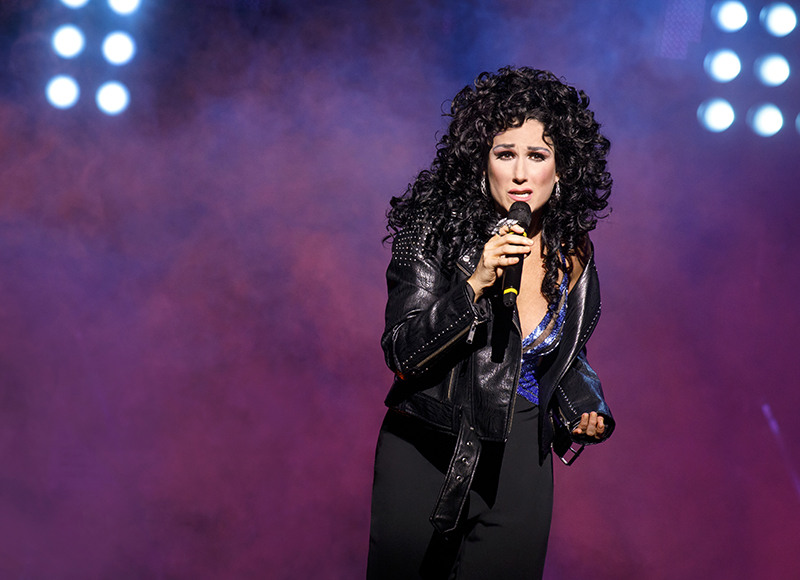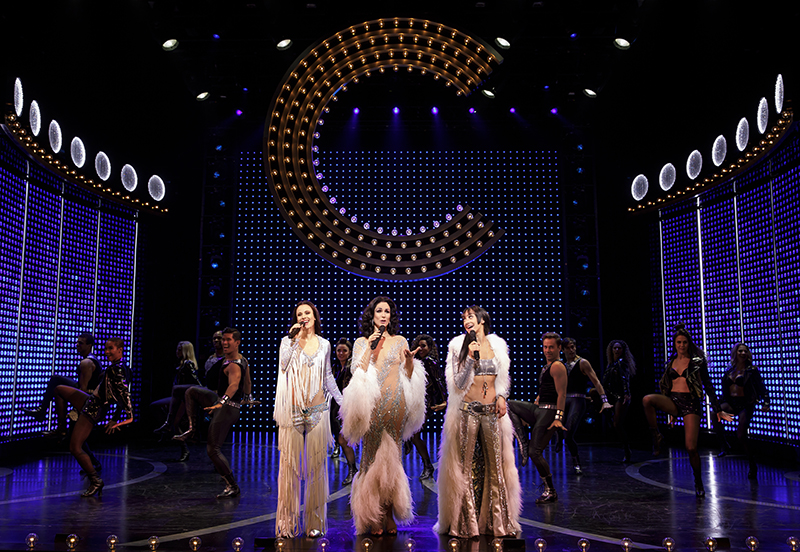
Razzle, Dazzle, Feathers and Glitter
As befits the glamour of its subject, The Cher Show features 683 costumes, 3,500 costume pieces and 6.5 million feathers, along with running 3,608 lighting queues and utilizing 7,432 light fixtures. Mirroring its star’s story of career reinvention, the Broadway musical underwent a big transformation between its Chicago run and its debut on the Great White Way. As veteran lighting designer Kevin Adams remarks, “It was a lot of show to make.”
The resulting hard work of cast and crew has produced a musical that pleases fans and grosses $1 million per week. The Cher Show chronicles the rise, success, downturn and career revival of Cher, from her early days with Sonny Bono through to her recent pop hits. Like the recent Donna Summer musical biography, it does so with three different actors (Stephanie J. Block, Micaela Diamond and Teal Wicks) playing Cher at different stages of her life, and the trio often interacts between major sequences. Other people including Cher’s mother, her first husband and mentor Sonny Bono, her second husband Gregg Allman (father to Elijah Blue) and iconic fashion designer Bob Mackie appear throughout the show, which is big, bold and colorful. It is an aesthetic that Adams is familiar with, having designed for musicals like American Idiot, Head Over Heels and Next To Normal.
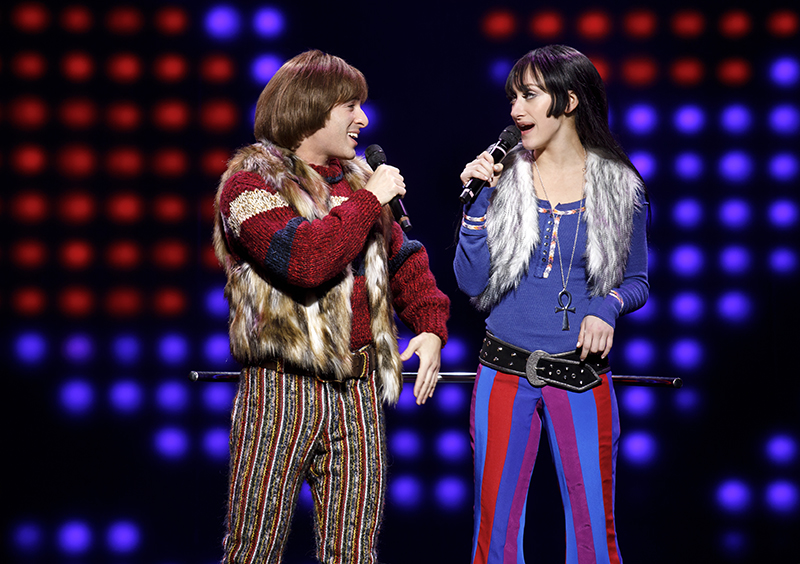
A 50-Plus Year Career
Adams did a huge amount of research through YouTube, watching several biographies on Cher’s life to learn about its overall arc as well as clarifying stories that had been often told about her life. There were also new, untold stories that Cher related through the show directly, including a funny Lucille Ball anecdote. He watched live concerts from 1980 through to her current Vegas residency. “This was helpful in looking for various ways that she tells parts of her life in different visual styles,” explains Adams.
Adams also watched recordings of TV shows from the 1970s, including The Sonny and Cher Show, The Flip Wilson Show, The Carol Burnett Show and The Donny and Marie Show. “The shows later in the decade were especially helpful, as they are completely over-the-top visually and really layer the sparkle and glitter,” he says. “From all of these variety shows, we were looking at different storytelling skit styles and also different kinds of sparkle and dazzle materials.”
About a year before they arrived in Chicago, Adams, director Jason Moore, and scenic designers Christine Jones and Brett J. Banakis spent countless hours in meetings, “mostly just sifting through early drafts of the script and discussing the basic storytelling elements of the show,” recalls Adams. “We didn’t get around to talking about what the show could look like for some time. We all agreed that every element would have some kind of sparkle or reflective element to it. The two large moving walls are covered on one side in faceted mirrors and on the other by Ayrton light panels. We did a series of tests looking at these panels, and we finally ended up diffusing them somewhat, as the beams were narrow and blindingly bright in their original form.”
The LD originally hoped to provide more side light with those Ayrton panels, but diffusing them made that goal harder to achieve. He had more control over the panels in Chicago, but relinquished much to the video team in New York to let them to produce content. Throughout the show, the two walls with flippers are placed at different angles.
“I like pointing things into those mirrors, especially when they’re flipping, because you could see things offstage or see things out in the house reflected,” says Adams. “I have all these vertical mini-strips around the stage that point into the stage, and they’re used not so much to light behind the walls, but when those mirrors flip around, you can see those vertical lines offstage. They’re reflected in the mirror. It’s very show biz-y.”
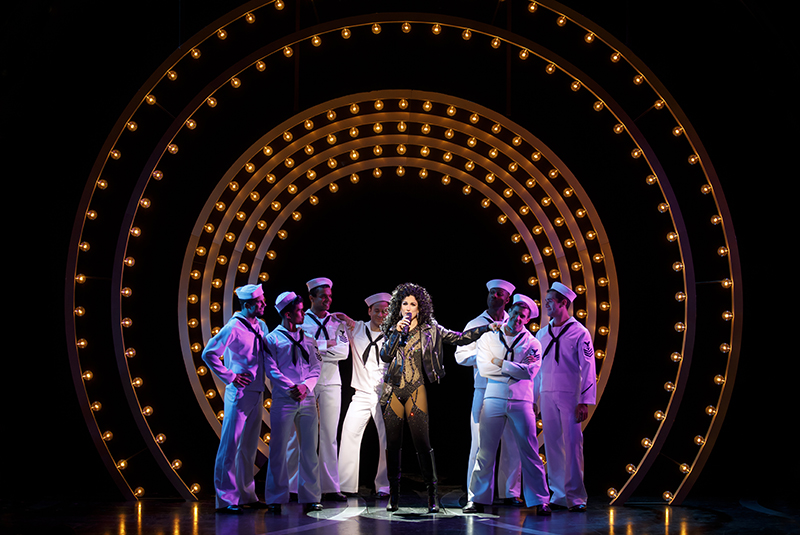
That 70’s Show Vibe
Early on, Adams knew that he wanted a few things in the proscenium, including a line of incandescent clear light bulbs, a line of LED multi-color tape, blinders with some kind of circular shape and moving lights. The light bulbs he chose are the clear round globes that were a staple of 1970’s-era variety shows, and they run across the front of the stage and across some of the scenery. “The contemporary four-color LED lines are uncovered and are similar to vertical lines found in the two moving walls,” he says. “And the blinders are individually controlled LED Rush Pars that are revealed through round holes in the proscenium. All of these elements can be used by themselves or together to create redundant frames of light around the proscenium and also to create different scales of spectacle.”
Programmer Benny Kirkham and Adams created a term for the style of show that many of the numbers inhabit: “Diva Pop.” “It’s heavy on heroic air gestures, rays and beams in smoke,” elaborates Adams, “and doesn’t rely on rock ‘n’ roll blinder effects in the way that most of our work together has.” (That work includes Hedwig and the Angry Inch, Blue Man Group in Vegas and SpongeBob SquarePants: The Broadway Musical.) Adams’ team also included associate lighting designer Paul Toben and assistant lighting designer Timothy Reed. Technical supervisor Neil Mazzella worked representing Hudson Theatrical Associates, and the lighting package was provided by PRG.
“I like how extreme the vocabulary of light is in the show,” declares Adams. “There are a lot of tonally somber scenes about marriage and career, and most of these are illuminated with a single unit or two, usually a VL3500 wash. They float in inky blackness. The dark scenes are, I think, surprisingly dark and not what the audience is expecting. Then at the other end of the spectrum is a show that is extremely bright, big and aggressively pushing toward the audience with layers of sparkle and illuminated surfaces.”
Adams started with an overhead grid of VL3500 Wash units, which he loves to use, and then filled in with Martin MAC Viper profile units. He says he also added a third kind of mover, the Claypaky Mythos 2, to give another layer of texture over the spot and profile units, noting that the Mythos units were especially helpful in creating the “Diva Pop” looks
“Other than all the LED on the scenery, there wasn’t a big LED lighting component to the show,” he says. “We originally had a layer of Solaris Flares in the plot that we had to cut for budget, but I have one all the way down left and right hidden low in the proscenium. They make a great low single source wash for the entire stage. I’m crazy about those Solaris Flares. After working with all LED Lekos in SpongeBob, I returned to scrollers and Source Fours as front light and side light on the onstage ladders. I have a layer of tall, vertical mini-strip booms offstage and upstage that are mostly used as scenery and are reflected in the spinning mirrors.”
Due to curved, actor-moved scenery frequently switching positions, he had no low side lighting option available, which made lighting the large dance numbers difficult. “Even if we had the units hung, the two large walls would have blocked them,” ascertains Adams. “It was definitely a challenge lighting the large ensemble numbers with no low side light. For the new finale of the show [in New York], we flew in two vertical trusses, each containing 13 Chauvet Intimidators. Our producers kept a very tight lid on weekly rental costs, so we purchased these for the Broadway production.
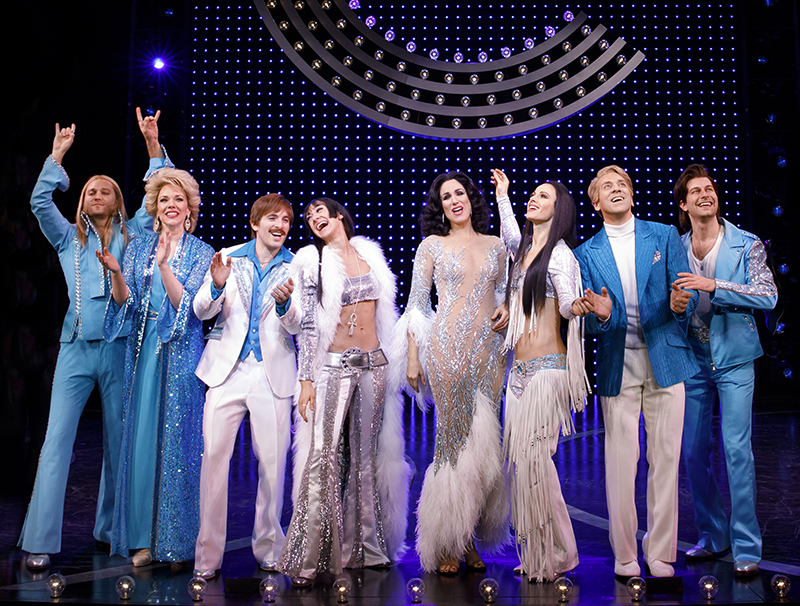
Chicago to NY Changes
The Cher Show went through a lot of changes between Chicago and New York. “After our Chicago tryout, we threw out at least 25 percent of the show for the Broadway production,” says Adams. “I’ve never worked on a show that overhauled as much show as we did. There was an entirely new framing device, new opening, a long, visually dense finale and several long sections of new show within acts. A lot of tech was just catching up to all the new content in the show. It kept us all very, very busy.”
The finale in Chicago began with Block singing a power ballad take on “Believe,” followed by the three Chers and their mother coming onstage, then closing with a big disco number, “Take Me Home.” The Broadway incarnation differs as it ends with a medley of her hits from the last 20 years, starting with “Believe.” Many book scenes and song selections were also cut from the Chicago version, whose opening was longer and involved a lot of design that was excised. The New York show also has a new opening. “We worked and worked and worked and worked [on the new finale] until opening, just layering and layering queues for that,” says Adams.
Overall, the Cher Show team had a month in Chicago of writing cues, dry tech and tech. In New York City, they had about two weeks of tech along with a lot of new material to rehearse over another two-week span. There is certainly “a lot of show” in the Cher musical. MA Lighting wrote new software for the show’s grandMA2 console because the manufacturer never had a show that required so many channels or cues before.
“One of the main goals of the set and lighting was not only to make a frame for the story and performances, but also to make a space that highlights the hundreds of costumes by Bob Mackie,” says Adams. “I have a huge amount of respect for Mr. Mackie, and we spent a small fortune on the clothes and support staff for the clothes. I wanted to make sure that every dollar of that gorgeous, fun and smart work showed.”
While Adams obtained color drawings of all of Mackie’s designs to work with initially, “I knew that once those costumes hit the stage, I would have a little more tuning in to what exactly his palette was or his colors were,” he says. “He was there every day. Even when we rehearsed in the afternoons without costumes, he was there, right across the aisle. He is really a remarkable man and a brilliant designer.”
Although he immersed himself in an intense technical experience with The Cher Show, Adams enjoyed working with the cast and crew. “The biggest challenge of the show, and the funny thing about it, is there was really nothing to light but floor and air and people in costumes,” says Adams. “I rarely had scenery to light and had no backgrounds to light really. All I had to light was a big, dirty floor and smoke in the air and that was really hard. It looks good considering how little there is to actually put light onto. We have a ton of templates and all those different kinds of movers that we use. We just used every trick that we could.”
Judging from the ecstatic audience reaction on the night that PLSN attended the show, that approach works just fine.
